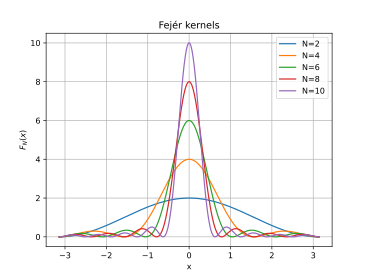Fejér kernel
In mathematics, the Fejér kernel is a summability kernel used to express the effect of Cesàro summation on Fourier series. It is a non-negative kernel, giving rise to an approximate identity. It is named after the Hungarian mathematician Lipót Fejér (1880–1959).
Definition
The Fejér kernel has many equivalent definitions. We outline three such definitions below:
1) The traditional definition expresses the Fejér kernel [math]\displaystyle{ F_n(x) }[/math] in terms of the Dirichlet kernel: [math]\displaystyle{ F_n(x) = \frac{1}{n} \sum_{k=0}^{n-1}D_k(x) }[/math]
where
- [math]\displaystyle{ D_k(x)=\sum_{s=-k}^k {\rm e}^{isx} }[/math]
is the kth order Dirichlet kernel.
2) The Fejér kernel [math]\displaystyle{ F_n(x) }[/math] may also be written in a closed form expression as follows[1]
[math]\displaystyle{ F_n(x) = \frac{1}{n} \left(\frac{\sin( \frac{nx}{2})}{\sin( \frac{x}{2})}\right)^2 = \frac{1}{n} \left(\frac{1 - \cos(nx)}{1 - \cos (x)}\right) }[/math]
This closed form expression may be derived from the definitions used above. The proof of this result goes as follows.
First, we use the fact that the Dirichlet kernel may be written as:[2]
- [math]\displaystyle{ D_k(x)=\frac{ \sin(k +\frac{1}{2})x}{\sin\frac{x}{2}} }[/math]
Hence, using the definition of the Fejér kernel above we get:
- [math]\displaystyle{ F_n(x) = \frac{1}{n} \sum_{k=0}^{n-1}D_k(x) = \frac{1}{n} \sum_{k=0}^{n-1} \frac{ \sin((k +\frac{1}{2})x)}{\sin(\frac{x}{2})} = \frac{1}{n} \frac{1}{\sin(\frac{x}{2})}\sum_{k=0}^{n-1} \sin((k +\frac{1}{2})x) = \frac{1}{n} \frac{1}{\sin^2(\frac{x}{2})}\sum_{k=0}^{n-1} [\sin((k +\frac{1}{2})x) \cdot \sin(\frac{x}{2})] }[/math]
Using the trigonometric identity: [math]\displaystyle{ \sin(\alpha)\cdot\sin(\beta)=\frac{1}{2}(\cos(\alpha-\beta)-\cos(\alpha+\beta)) }[/math]
- [math]\displaystyle{ F_n(x) =\frac{1}{n} \frac{1}{\sin^2(\frac{x}{2})}\sum_{k=0}^{n-1} [\sin((k +\frac{1}{2})x) \cdot \sin(\frac{x}{2})] = \frac{1}{n} \frac{1}{2\sin^2(\frac{x}{2})}\sum_{k=0}^{n-1} [\cos(kx)-\cos((k+1)x)] }[/math]
Hence it follows that:
- [math]\displaystyle{ F_n(x) = \frac{1}{n} \frac{1}{\sin^2(\frac{x}{2})}\frac{1-\cos(nx)}2=\frac{1}{n} \frac{1}{\sin^2(\frac{x}{2})}\sin^2(\frac{nx}2) =\frac{1}{n} (\frac{\sin(\frac{nx}2)}{\sin(\frac{x}{2})})^2 }[/math]
3) The Fejér kernel can also be expressed as:
[math]\displaystyle{ F_n(x)=\sum_{ |k| \leq n-1} \left(1-\frac{ |k| }{n}\right)e^{ikx} }[/math]
Properties
The Fejér kernel is a positive summability kernel. An important property of the Fejér kernel is [math]\displaystyle{ F_n(x) \ge 0 }[/math] with average value of [math]\displaystyle{ 1 }[/math].
Convolution
The convolution Fn is positive: for [math]\displaystyle{ f \ge 0 }[/math] of period [math]\displaystyle{ 2 \pi }[/math] it satisfies
- [math]\displaystyle{ 0 \le (f*F_n)(x)=\frac{1}{2\pi}\int_{-\pi}^\pi f(y) F_n(x-y)\,dy. }[/math]
Since [math]\displaystyle{ f*D_n=S_n(f)=\sum_{|j|\le n}\widehat{f}_je^{ijx} }[/math], we have [math]\displaystyle{ f*F_n=\frac{1}{n}\sum_{k=0}^{n-1}S_k(f) }[/math], which is Cesàro summation of Fourier series.
By Young's convolution inequality,
- [math]\displaystyle{ \|F_n*f \|_{L^p([-\pi, \pi])} \le \|f\|_{L^p([-\pi, \pi])} \text{ for every } 1 \le p \le \infty \text{ for } f\in L^p. }[/math]
Additionally, if [math]\displaystyle{ f\in L^1([-\pi,\pi]) }[/math], then
- [math]\displaystyle{ f*F_n \rightarrow f }[/math] a.e.
Since [math]\displaystyle{ [-\pi,\pi] }[/math] is finite, [math]\displaystyle{ L^1([-\pi,\pi])\supset L^2([-\pi,\pi])\supset\cdots\supset L^\infty([-\pi,\pi]) }[/math], so the result holds for other [math]\displaystyle{ L^p }[/math] spaces, [math]\displaystyle{ p\ge1 }[/math] as well.
If [math]\displaystyle{ f }[/math] is continuous, then the convergence is uniform, yielding a proof of the Weierstrass theorem.
- One consequence of the pointwise a.e. convergence is the uniqueness of Fourier coefficients: If [math]\displaystyle{ f,g\in L^1 }[/math] with [math]\displaystyle{ \hat{f}=\hat{g} }[/math], then [math]\displaystyle{ f=g }[/math] a.e. This follows from writing [math]\displaystyle{ f*F_n=\sum_{|j|\le n}\left(1-\frac{|j|}{n}\right)\hat{f}_je^{ijt} }[/math], which depends only on the Fourier coefficients.
- A second consequence is that if [math]\displaystyle{ \lim_{n\to\infty}S_n(f) }[/math] exists a.e., then [math]\displaystyle{ \lim_{n\to\infty}F_n(f)=f }[/math] a.e., since Cesàro means [math]\displaystyle{ F_n*f }[/math] converge to the original sequence limit if it exists.
See also
- Fejér's theorem
- Dirichlet kernel
- Gibbs phenomenon
- Charles Jean de la Vallée-Poussin
References
- ↑ Hoffman, Kenneth (1988). Banach Spaces of Analytic Functions. Dover. p. 17. ISBN 0-486-45874-1.
- ↑ Konigsberger, Konrad (in German). Analysis 1 (6th ed.). Springer. pp. 322.
 |


